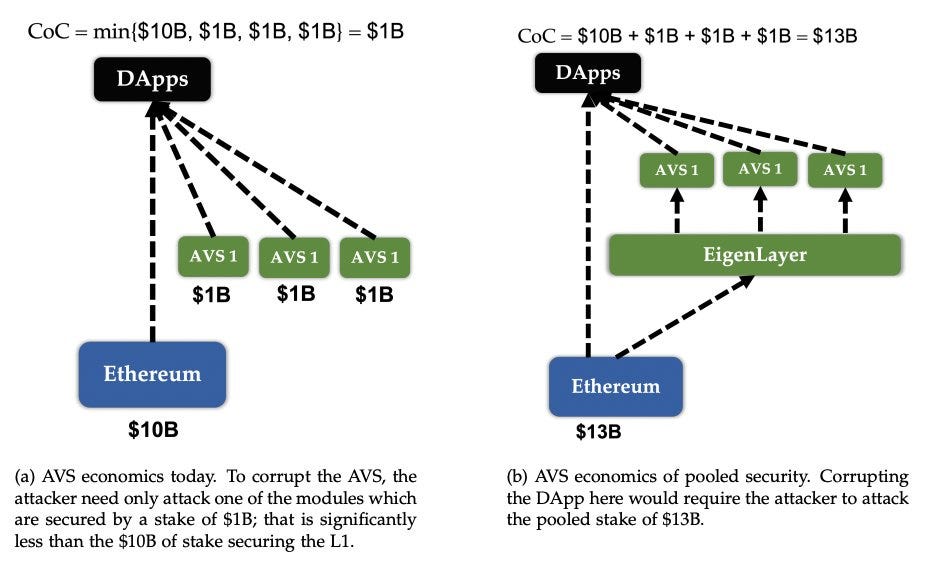Explaining Eigenlayer and the Restaking Hype
Revolutionizing Ethereum Staking & Yield: EigenLayer Unveils Innovative Restaking Model
In the dynamic world of blockchain technology, EigenLayer is making headlines for its innovative model, transforming the way Ethereum validators secure Autonomous Validation Systems (AVS). Each AVS, under the EigenLayer model, enjoys the protective shield of the entire stake from Ethereum validators.
This consolidation of security not only strengthens Ethereum's defenses but also raises the bar for potential attackers, demanding a significantly larger stake to compromise any AVS.
What is eigenlayer and how does it relate to restaking
EigenLayer is a transformative protocol on the Ethereum blockchain that introduces the concept of restaking, enabling users to earn additional rewards by reallocating their staked assets to secure multiple decentralized applications and services within the Ethereum network. This process optimizes the staked capital base and enhances cryptoeconomic security across various protocols. EigenLayer is designed to extend the utility and security of Ethereum, allowing simultaneous opt-ins to multiple security pools, reducing the capital entry barrier, and enhancing system-wide trust levels.
Restaking, as facilitated by EigenLayer, allows users to stake the same ETH on both Ethereum and other protocols, thereby contributing to the security of multiple applications and earning additional rewards. EigenLayer also supports the liquid staking of various tokens like stETH, rETH, cbETH, and LsETH, further expanding its utility and potential impact within the Ethereum ecosystem.
EigenLayer Pioneering the Restaking Frontier
At the heart of this security revolution is EigenLayer, the platform at the forefront of the restaking phenomenon. Serving as a collection of smart contracts, EigenLayer empowers validators to restake through Liquid Staking Tokens (LSTs) or native staking. The intricate design of these contracts goes beyond facilitating restaking; it meticulously outlines slashing rules and rewards for both validators and AVS, creating a transparent and incentive-driven ecosystem.
Restaking: Redefining Ethereum Validator Strategy
Traditionally, Ethereum validators staked their holdings to secure the network, a commitment integral to the Proof-of-Stake (PoS) consensus mechanism. EigenLayer injects a paradigm shift with the introduction of restaking—a process where validators can strategically redeploy their staked assets across multiple networks and services. This innovative approach fundamentally alters the validator strategy, introducing a level of flexibility and efficiency previously unseen.
AVS Customization and the Birth of a Free Market
EigenLayer introduces a game-changing feature allowing each AVS to determine its required stake and corresponding rewards for validators. This customization empowers validators to selectively opt into the AVS of their choice, effectively establishing a free market dynamic. This approach enables external protocols to enter into a security marketplace, purchasing protection from Ethereum validators through restaking – a departure from traditional security models.
Ethereum's Key Takeaway: Security and Decentralization Reinforced
The essence of the discussion revolves around a key revelation: Ethereum's inherent security and decentralization. EigenLayer emerges as the bridge connecting protocols beyond smart contracts to Ethereum's security infrastructure through restaking, a capability that was once deemed impractical.
Navigating Security Challenges in Ethereum DApps: The EigenLayer Perspective
In the realm of Ethereum DApps relying on multiple protocols, security intricacies come to the forefront. This dynamic interplay is analogous to a chain, where the security strength is determined by the weakest link. In EigenLayer's context, the pooled security of AVS introduces both resilience and vulnerability.
Consider an Ethereum DApp utilizing various protocols, with one AVS boasting a substantial $1 billion stake. While this magnifies the DApp's overall security, it also spotlights a potential weak point. An attacker could exploit the AVS with the massive stake rather than attempting a broader breach of the Ethereum network.
To mitigate risks, developers must diversify stakes across multiple AVS, preventing a single point of failure. Continuous monitoring, robust slashing mechanisms, and adherence to security best practices become imperative. EigenLayer's collective security model, though not immune to the weakest link dilemma, significantly raises the bar for potential attackers. By pooling AVS security, EigenLayer minimizes the impact of a breach, requiring attackers to contend with the aggregated security of the entire Ethereum network.
Endless Protocols on EigenLayer
While the focus has primarily been on security enhancements, the discussion opens the door to a world of possibilities on EigenLayer. The platform serves as a fertile ground for the creation of diverse protocols, from Decentralized Autonomous (DA) layers to decentralized sequencers, bridges, and oracles. EigenLayer sparks curiosity about the myriad applications waiting to be explored within this innovative ecosystem.
In conclusion, EigenLayer is not merely a technological advancement; it is a paradigm shift in the way we perceive Ethereum's security. As the restaking hype continues to build momentum, EigenLayer promises not just enhanced security but a vast landscape of opportunities for blockchain applications.






